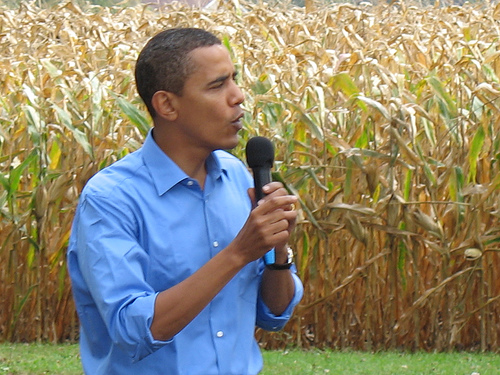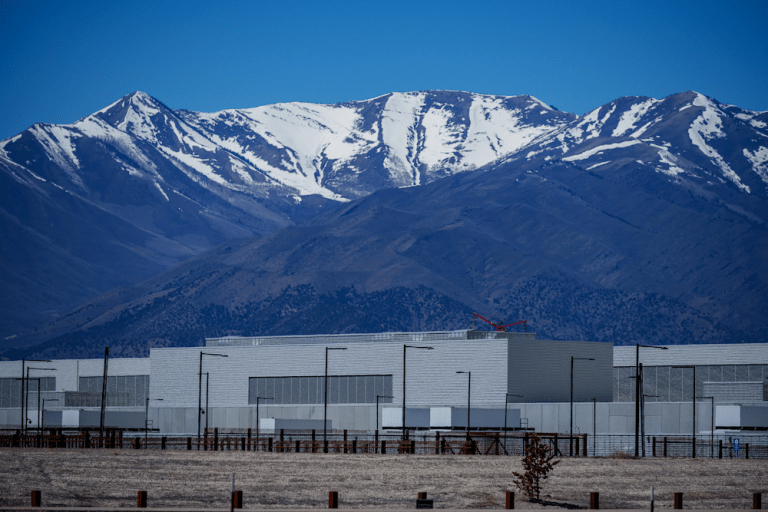 Like a tractor driven by a drunk, the Obama administration keeps zigzagging on food/ag policy–sometimes veering in the direction of progressive change, other times whipping back toward the agrichemical status quo.
Like a tractor driven by a drunk, the Obama administration keeps zigzagging on food/ag policy–sometimes veering in the direction of progressive change, other times whipping back toward the agrichemical status quo.
In the last couple of days, there’s been a sharp turn toward the status quo. As I reported yesterday, Obama plucked Islam “Isi” Siddiqui from the nation’s most powerful agrichemical lobby group and made him our chief negotiator on ag issues in global trade talks. This is a major coup for Big Ag. Ramming open foreign markets for our cheap food commodities and pricey ag inputs is critical to the industry’s future profits–and perilous for global food security and the environment.
And today, Obama’s Big Ag side got the best of him again. He tapped Roger Beachy, long-time president of the Danforth Plant Science Center, as chief of the USDA’s newly created National Institute of Food and Agriculture (NIFA).
A creation of the 2008 Farm Bill, the NIFA “replaces the Cooperative State Research, Education, and Extension Service, which distributes $200 million in competitive grants and about $280 million in ‘formula funding’ to land-grant universities,” Science blog reports.
Science continues:
The Farm Bill adds another $106 million annually of competitive funding for research into organic farming, biomass, and fruits and vegetables. It also calls for a “distinguished scientist” to be appointed for a 6-year term as director.
So this is a critical post. If the sustainable farming movement is going to scale up and really start providing a large portion of the nation’s calories–and deliver on its potentially huge environmental promises–than we’re going to need a significant commitment of federal research dollars.
 Roger BeachyPhoto: Courtesy of the Danforth CenterAnd what are we getting with the appointment of Beachy? The Danforth Plant Science Center, nestled in Monsanto’s St. Louis home town, is essentially that company’s NGO research and PR arm. According to its website, the center “was founded in 1998 through gifts from the St. Louis-based Danforth Foundation, the Monsanto Fund (a philanthropic foundation), and a tax credit from the State of Missouri.”
Roger BeachyPhoto: Courtesy of the Danforth CenterAnd what are we getting with the appointment of Beachy? The Danforth Plant Science Center, nestled in Monsanto’s St. Louis home town, is essentially that company’s NGO research and PR arm. According to its website, the center “was founded in 1998 through gifts from the St. Louis-based Danforth Foundation, the Monsanto Fund (a philanthropic foundation), and a tax credit from the State of Missouri.”
Monsanto CEO Hugh Grant sits on the center’s board of trustees, along with execs from defense giant McDonnell Douglas and pharma titan Merck. Another notable board member is Alfonso Romo, a Mexican magnate who cashed in big during his country’s notoriously corrupt privatization /liberalization bonanza in the early ’90s.
Romo used his connections to build a company called Seminis into the globe’s biggest vegetable-seed concern, with dreams (as yet unrealized) of loads of new GMO veggie varieties. Monsanto bought Seminis in 2005. Here’s a revealing Wall Street Journal profile of Romo from 1999; and here’s what I wrote about him and the Monsanto/Seminis tie up back in 2005. (Interesting tidbit: Romo claims credit for innovating those insipid and ubiquitous “baby carrots”; and for reducing the spiciness of jalepeno peppers.)
On its short list of “partners” we find several research-oriented universities and one corporation: Monsanto. In the Danforth Center’s 2007 annual report (PDF), Monsanto is mentioned no fewer than ten times funding this or that project.
So essentially, the public face of Monsanto’s research efforts now has his fingers on the USDA’s research purse strings. Score a big one for agribusiness!
So Obama has become an agribiz shill, right? Well, it’s not nearly so simple.
Last winter, the administration tapped Kathleen Merrigan as deputy USDA secretary. This is traditionally a powerful position within the agency; under Bush, a paid-up industrial corn man held the post. Merrigan has pristine credentials as an organic advocate–and from the whispers I’ve heard, has been pushing that agenda within USDA.
I’m told she’s met with many prominent sustainable-ag advocates–folks who were completely frozen out by the Bush USDA. The latest: On Twitter, Michel Dimock of California’s Roots of Change recently announced he has “4 mtngs w/ USDA nxt 2 days.” That sort of access simply wasn’t available at Bush’s USDA.
Then there’s Merrigan’s brainchild, “The Know Your Farmer Know Your Food” initiative (complete with splashy new web site). It’s essentially an attempt to alert players in the sustainable food movement to possibilities of getting existing USDA funding. (I wrote briefly about its limits and promise lat week.) Again, you can call the initiative largely symbolic, but nothing remotely like it was happening under Bush.
It’s certainly energizing sustainable ag NGO chiefs. On Chews Wise blog, Sam Fromartz reports that such folks are “pumped” by the initiative. He asked several for their reactions. Words like “fantastic,” “thrilling,” and “quite encouraging” tripped off their tongues.
Meanwhile, Michelle Obama–and her food ambassador, White House assistant chef/gardener Sam Kass–continues to push sustainable ag from the East Wing. One can assume she has some influence in the Oval Office.
So what’s going on here? Whither the Obama administration on food and ag–toward a food future that seeks big, top-down, corporate-led answers, always straining to leapfrog ecological limits–and creating new sets of problems to be (lucratively) solved? Or toward one that works within ecological limits, builds resilience, and generates wealth and health within communities?
Right now, we’re getting a kind of policy whiplash. But I have a conjecture–based completely on my own observation, not on any inside info. I’ll give it here; and I urge readers to give their own conjectures below.
My conjecture is this: Obama likes cutting-edge ideas. You look at the ag landscape, and you see two distinct areas with great innovation, energy, and movement: biotech and organic/sustainable. So he’s coming out strong behind both camps, and plans to sit back and see which one develops the best ideas.
The problem is that the biotech side has a massive advantage in terms of resources; and, as I’ve shown before, has benefitted from years of government cronyism and coddling. Moreover, it utterly dominates the university research agenda, aided by the draconian intellectual rights the government has awarded it.
So if Obama is setting up a kind of contest between the two camps, the game is rigged in advance.
That’s what I think. Please write what you think below.



